Last night, we had CMT’s Hee Haw Weekend Marathon on while Amy worked up a dose of Emeril’s spicy tomato glaze. My parents didn’t watch Hee Haw much when I was a kid, although my dad developed an unhealthy attachment to Willie Nelson in the 1980s (unhealthy inasmuch as he really loved that duet with Julio Iglesias). My in-laws asked if I listened to Buck Owens. I told them I never did, but that Amy was pretty broken up when Owens died this year.
I made my first visit to a Wal-Mart yesterday. Where I live (northern NJ) it’s not a huge feat to avoid them; my grocery needs aren’t extensive and the only store I know of nearby is up in Western Samaria (aka Rt. 59 in NY state). Down here, it’s more of a necessity, especially post-Katrina. I took one step inside and Got It: huge, well-lit venue, cleaner than any of the local markets, good selection of food products. And then there’s all the other stuff: a family passed us with a shopping cart filled with food, back-to-school clothing, and a color inkjet printer. Wal-Mart doesn’t carry everything, of course.
In the “efnic food” aisle, we bumped into Amy’s cousin Wade, whom I last saw during his visit to NYC with his wife. He pines to retun to the city.
I always wonder about how different regions see each other. It reminds me of that scene in Annie Hall, when Woody Allen tells Tony Roberts, “Don’t you see? The rest of the country looks upon New York like we’re left-wing, Communist, Jewish, homosexual, pornographers. I think of us that way, sometimes, and I live here!” But Wade really liked visiting, and no one down here’s given me any crap for, um, being who I am. Even if the housepet is a little judgemental.
The news here is focused on yesterday’s six murders — the murder rate is skyrocketing this year — but the top story is that Reggie Bush signed his rookie contract with the Saints. In the Times-Pic, it takes top billling over a misguided idea to build a “Jazz Park” to replicate Chicago’s Millennium Park.
Tonight, we’re staying in New Orleans at the same hotel we stayed in leading up to our wedding. I’m flooded with memories of last March, and so is Amy. We had a little snack (if that’s possible) at Café Du Monde, and reminisced about the end of our wedding evening. I love being in this city, but I have a hard time imagining how it’s going to recover from the disaster last year. I’m glad we did what we could to boost the economy via our friends’ alcohol consumption.
It’s a Sunday afternoon in mid-summer, so it’s kind of dead outside. I was hoping to get some good pictures, but there really isn’t much to see that I haven’t snapped in past trips. We’ll be dining at NOLA tonight, then getting up earlyish to fly home. If I do manage any good pix tonight, you’ll be the first to know.
